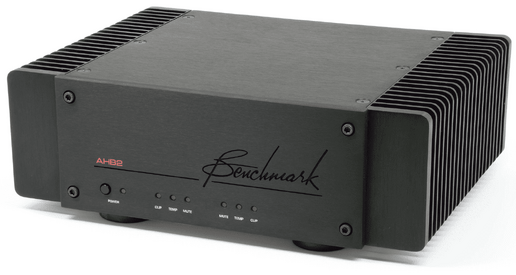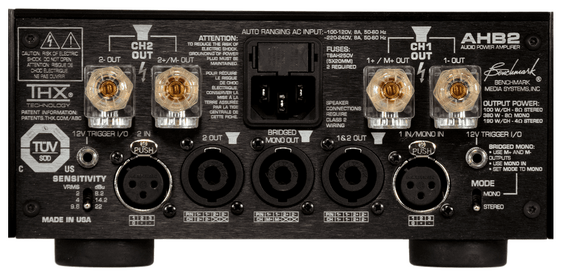Sonnie Parker
Senior Admin
More
- Preamp, Processor or Receiver
- StormAudio ISP Elite 24 MK3 Processor
- Main Amp
- McIntosh MC1.25KW Monoblock Amps
- Additional Amp
- StormAudio PA 16 MK3
- Other Amp
- McIntosh MA252 2-Channel Hybrid Integrated Amp
- Music Server
- ROON Nucleus One
- Universal / Blu-ray / CD Player
- Magnetar UDP800 UHD Player
- Streaming Equipment
- Kaleidescape Strato C Media Player
Kaleidescape Terra Prime 22TB Server
Lenovo X1 Carbon
Apple TV 4K
- Turntable/Cartridge
- Music Hall Stealth Turntable
Ortofon 2M Blue Cartridge
- Streaming Subscriptions
- Lifetime Roon Subscription
Tidal
qobuz
Netflix
Amazon Prime
- Other Equipment
- MediaLight Mk2 v2 Flex Bias Lighting
Zero Surge 8R15W-1
Zero Surge 2R20W
- Front Speakers
- RTJ 410
- Front Wide Speakers
- JTR Noesis 110HT
- Center Channel Speaker
- MartinLogan Focus C-18
- Surround Speakers
- JTR Noesis 210RT
- Surround Back Speakers
- JTR Noesis 210RT
- Front Height Speakers
- JTR Noesis 110HT-SL
- Middle Height Speakers
- JTR Noesis 110HT-SL
- Rear Height Speakers
- JTR Noesis 110HT-SL
- Subwoofers
- JTR Captivator - 4000ULF-TL x2 + 2400 x6
- Bass Shaker System
- Dayton Audio BSA-200 Amp
4 BST-1 Bass Shakers
- Other Speakers
- Wharfedale Super Linton
- Video Display Device
- Sony 98X90L
- Remote Control
- URC MX-890
- Cables
- AudioQuest - Various
THX PixelGen HDMI
Pangea Power Cables
Blue Jeans Cables
SVS Soundpath Cables
Custom Cables
- Satellite System
- Dish Joey 4K
- Other Equipment
- Salamander Synergy Equipment Stand
VTI Amp Stands for the Monoblocks
Solidsteel - S3 Series Amp Stand
- Network/Internet
- C-Spire 1Gig Fiber
Omada OC300 Controller
Omada ER8411 10G Router
Omada SG3218XP-M2 10G/2.5G Managed Switch
Omada SG2210XMP-M2 10G/2.5G Managed Switch
SilentPower LAN iPurifier Pro (for Nucleus One)
Asustor Flashstor NAS
- Headphones/IEMs
- HIFIMAN HE1000se
Unique Melody Mest MKII
- Headphone DAC/Amp
- Eversolo DMP-A6
RME ADI-2 DAC FS
HIFIMAN Goldenwave Serenade
- Whole House System
- HEOS System
Home-150 Speaker x6
Samsung S9 Tablet w/ HEOS
- Office/Study System
- Office System
Dell Precision Computer
Roon Networked
Vanatoo Transparent One Encore Plus Speakers
- Secondary/Additional Room System
- AV Test Room System
NAD M33 Streaming DAC Amp
MartinLogan Motion XT F200
JTR Captivator RS1
miniDSP EARS
Zero Surge 8R15W-1
Zero Surge 2R20W
Dell Optiplex
Roon Networked
- Additional Room System
- Sunroom System
Denon AVR-X1800H HEOS Roon Ready Receiver
Zu Audio DW-6 Speakers
Dayton Audio IO8XTW Outdoor Speakers
Roon Networked
Dish Joey
JVC 37" TV
- Additional Room System
- Cabin System
Onkyo TX-SR805 Receiver
Infinity Primus P163 Speakers
RSL Outsiders Outdoor Speakers
Shield TV Pro
Sony 55" TV
- Additional Room System
- Vinyl Room
Accuphase E-280 Integrated Amp
Technics SL-1210GR2 Turntable
Ortofon 2M Blue Cartridge
KLH Model Three Speakers
Zero Surge 8R15W-1
- Additional Room System
- Barn Jam
Denon AVR-X1600H HEOS Roon Ready Receiver
Soundfield Custom Speakers
I really don't know, but Benchmark makes the claim, and if it's not, it's most certainly "one of" the quietest and cleanest amps in the universe.
Benchmark Media Systems AHB2 Power Amplifier - https://benchmarkmedia.com/collections/amp/products/benchmark-ahb2-power-amplifier


You can see the full specs on their website, but here are some notables:
SNR & Dynamic Range
Rated output relative to output noise, inputs shorted
Output noise relative to 2.83 Vrms, A-weighted, inputs shorted
1 kHz, 80 kHz LPF, at full rated output into any rated load
1 kHz, 20 kHz LPF, at full rated output into any rated load
A black pair landed at my shop today and I happily brought them home with me, since I paid good money for them. These will power my ML 15A's in mono mode. I learned from talking with Rory Rall of Benchmark that they have paired up the AHB2 amps with several MartinLogan speakers over the past few years at various audio shows to show how well they pair with electrostatic speakers.
Lately I've been considering a little higher end gear to make sure I'm not missing anything in my music listening. Yet I've always been a proponent of not being able to identify any audible differences in quality solid state amps, which includes most all amps as far as I'm concerned, provided they are not over-driven. I am NOT stating there are no audible differences, and it does NOT mean I am NOT hearing a difference. I'm just not good at identifying the differences like some others that are apparently able to do so. However, what I don't want is anything to possibly hinder me from hearing the best I can hear, or at least that is what I am chasing right now. I believe the AHB2 amps will be a significant part of my music listening system.
While investigating these amps I enjoyed reading Benchmark's VP and chief designer John Siau's application notes... some very interesting articles; https://benchmarkmedia.com/blogs/application_notes
The first paragraph of his Listening vs. Measuring article caught my attention right away.
At Benchmark, listening is the final exam that determines if a design passes from engineering to production. When all of the measurements show that a product is working flawlessly, we spend time listening for issues that may not have shown up on the test station. If we hear something, we go back and figure out how to measure what we heard. We then add this test to our arsenal of measurements.
Even though measurements show no flaws, they still listen, and if they identify something different, they figure out a way to measure what they heard. This is truly amazing to me. Take a look at the products they make, and take a look a the specs, and look at the unbelievably crazy good specs verified by numerous people taking measurements with the best gear available to do so. Then imagine that these guys at Benchmark STILL listen for differences and THEN figure out a way to measure those differences. They firmly believe that if they hear a difference, they should be able to measure it.
I appreciate what Paul Seydor of the abo!ute sound wrote in his review of the AHB2... here are a few clips from his review...
I don’t have much to say about the sonic qualities of Benchmark’s new AHB2 power amplifier because there isn’t that much to say. Used within its limitations and for its intended purposes it is in any practical sense perfect. I know this is not the sort of thing we’re supposed to say about products, but it has been evident for a very long time now that solid-state electronics, particularly linestage preamplifiers and power amplifiers, have reached a point where they are effectively a solved problem such that it is exceeding difficult to tell one from another even in the most exacting A/B comparisons. Ferretting out differences typically involves zeroing in on a very specific and limited characteristic or set of characteristics with such concentration as to leave one tired, uncertain, or both: in other words, an activity that is the very antithesis of what is involved in listening seriously, even critically—to say nothing of pleasurably—to music. [I must point out that this view is not shared by the TAS editorial staff. —RH]
That said, even by contemporary standards of the most sophisticated, exotic, and expensive electronics, this new amplifier is something of a technological tour de force.
As a remarkable number of audiophiles still tend to listen with their eyes rather than their ears, there continues to be a prejudice in favor of size, weight, and bulk, especially as regards speaker systems and amplifiers. I have no wish to engage the double-blind test debate here, but I do think there’s a lot to be said for not knowing what you’re listening to when evaluating components, particularly when it comes to electronics. The truth is that if electronics, particularly solid-state electronics, are correctly designed, they just work: When they don’t sound neutral the reason is typically some limitation or flaw in the design, being pushed beyond their rated power, an interaction with untoward speaker loads and/or cabling, or a flavor the designer consciously built into it (e.g., the exceptionally pretty Gundry dip Bob Carver designed into his Sunfire amplifiers). (full review) (underlined emphasis by me)
This to me is when honesty and reality are harmonized beautifully by a reviewer.
Then we have our good friend Kal Rubinson's review of the AHB2 at Stereophile... which is where I was surprised to learn that the AHB2 was a collaboration between Benchmark and THX... another interesting bit of technology and information. Kal seems to be more like one of us, instead of being like so many of the other reviewers for which I withhold the words that might describe them, partially out of respect for what they do. I admit, there's just not many reviewers I trust or care for... sorry, but I can't apologize for them. Benchmark might thank Kal for tilting my decision to purchase these amps based on his comments as follows....
Benchmark and THX make much of the AHB2's lack of audible noise: something good systems aren't troubled by in any case. That said, it was probably the AHB2's low noise level that revealed to me much more apparent low-level detail in already-familiar recordings. I qualify that statement with apparent because, after hearing the AHB2 uncover previously unheard subtle details, I found I could now hear them when I returned to my other amps. I suspect that, being newly informed of their existence, my ear/brain could more easily extract those details from the output provided all along by my other amplifiers. This made a much greater impression on me than any subjective awareness of a lower noise floor, per se. (full reivew)
Thank Kal for turning me on to O-Zone Percussion Group: La Bamba... that's some good stuff... diggin' the Jazz Variants.
The AHB2 is simply another part of the chain in my chase for the near perfect two-channel system build. I'm not there yet, but I'm close, and I hope the AHB2's will play a big part in not holding anything back from my reaching audio nirvana.
Benchmark Media Systems AHB2 Power Amplifier - https://benchmarkmedia.com/collections/amp/products/benchmark-ahb2-power-amplifier


You can see the full specs on their website, but here are some notables:
SNR & Dynamic Range
Rated output relative to output noise, inputs shorted
- 132 dB A-weighted, Stereo Mode
- 135 dB A-weighted, Mono Mode
- 130 dB Unweighted, 20 Hz to 20 kHz, Stereo Mode
- 133 dB Unweighted, 20 Hz to 20 kHz, Mono Mode
Output noise relative to 2.83 Vrms, A-weighted, inputs shorted
- -112 dB, Stereo Mode
- -109 dB, Mono Mode
1 kHz, 80 kHz LPF, at full rated output into any rated load
- < -118 dB (< 0.00013%), Stereo Mode
- < -118 dB (< 0.00013%), Mono Mode
1 kHz, 20 kHz LPF, at full rated output into any rated load
- < -119 dB (< 0.00011%), Stereo Mode
- < -120 dB (< 0.00010%), Mono Mode
A black pair landed at my shop today and I happily brought them home with me, since I paid good money for them. These will power my ML 15A's in mono mode. I learned from talking with Rory Rall of Benchmark that they have paired up the AHB2 amps with several MartinLogan speakers over the past few years at various audio shows to show how well they pair with electrostatic speakers.
Lately I've been considering a little higher end gear to make sure I'm not missing anything in my music listening. Yet I've always been a proponent of not being able to identify any audible differences in quality solid state amps, which includes most all amps as far as I'm concerned, provided they are not over-driven. I am NOT stating there are no audible differences, and it does NOT mean I am NOT hearing a difference. I'm just not good at identifying the differences like some others that are apparently able to do so. However, what I don't want is anything to possibly hinder me from hearing the best I can hear, or at least that is what I am chasing right now. I believe the AHB2 amps will be a significant part of my music listening system.
While investigating these amps I enjoyed reading Benchmark's VP and chief designer John Siau's application notes... some very interesting articles; https://benchmarkmedia.com/blogs/application_notes
The first paragraph of his Listening vs. Measuring article caught my attention right away.
At Benchmark, listening is the final exam that determines if a design passes from engineering to production. When all of the measurements show that a product is working flawlessly, we spend time listening for issues that may not have shown up on the test station. If we hear something, we go back and figure out how to measure what we heard. We then add this test to our arsenal of measurements.
Even though measurements show no flaws, they still listen, and if they identify something different, they figure out a way to measure what they heard. This is truly amazing to me. Take a look at the products they make, and take a look a the specs, and look at the unbelievably crazy good specs verified by numerous people taking measurements with the best gear available to do so. Then imagine that these guys at Benchmark STILL listen for differences and THEN figure out a way to measure those differences. They firmly believe that if they hear a difference, they should be able to measure it.
I appreciate what Paul Seydor of the abo!ute sound wrote in his review of the AHB2... here are a few clips from his review...
I don’t have much to say about the sonic qualities of Benchmark’s new AHB2 power amplifier because there isn’t that much to say. Used within its limitations and for its intended purposes it is in any practical sense perfect. I know this is not the sort of thing we’re supposed to say about products, but it has been evident for a very long time now that solid-state electronics, particularly linestage preamplifiers and power amplifiers, have reached a point where they are effectively a solved problem such that it is exceeding difficult to tell one from another even in the most exacting A/B comparisons. Ferretting out differences typically involves zeroing in on a very specific and limited characteristic or set of characteristics with such concentration as to leave one tired, uncertain, or both: in other words, an activity that is the very antithesis of what is involved in listening seriously, even critically—to say nothing of pleasurably—to music. [I must point out that this view is not shared by the TAS editorial staff. —RH]
That said, even by contemporary standards of the most sophisticated, exotic, and expensive electronics, this new amplifier is something of a technological tour de force.
As a remarkable number of audiophiles still tend to listen with their eyes rather than their ears, there continues to be a prejudice in favor of size, weight, and bulk, especially as regards speaker systems and amplifiers. I have no wish to engage the double-blind test debate here, but I do think there’s a lot to be said for not knowing what you’re listening to when evaluating components, particularly when it comes to electronics. The truth is that if electronics, particularly solid-state electronics, are correctly designed, they just work: When they don’t sound neutral the reason is typically some limitation or flaw in the design, being pushed beyond their rated power, an interaction with untoward speaker loads and/or cabling, or a flavor the designer consciously built into it (e.g., the exceptionally pretty Gundry dip Bob Carver designed into his Sunfire amplifiers). (full review) (underlined emphasis by me)
This to me is when honesty and reality are harmonized beautifully by a reviewer.
Then we have our good friend Kal Rubinson's review of the AHB2 at Stereophile... which is where I was surprised to learn that the AHB2 was a collaboration between Benchmark and THX... another interesting bit of technology and information. Kal seems to be more like one of us, instead of being like so many of the other reviewers for which I withhold the words that might describe them, partially out of respect for what they do. I admit, there's just not many reviewers I trust or care for... sorry, but I can't apologize for them. Benchmark might thank Kal for tilting my decision to purchase these amps based on his comments as follows....
Benchmark and THX make much of the AHB2's lack of audible noise: something good systems aren't troubled by in any case. That said, it was probably the AHB2's low noise level that revealed to me much more apparent low-level detail in already-familiar recordings. I qualify that statement with apparent because, after hearing the AHB2 uncover previously unheard subtle details, I found I could now hear them when I returned to my other amps. I suspect that, being newly informed of their existence, my ear/brain could more easily extract those details from the output provided all along by my other amplifiers. This made a much greater impression on me than any subjective awareness of a lower noise floor, per se. (full reivew)
Thank Kal for turning me on to O-Zone Percussion Group: La Bamba... that's some good stuff... diggin' the Jazz Variants.
The AHB2 is simply another part of the chain in my chase for the near perfect two-channel system build. I'm not there yet, but I'm close, and I hope the AHB2's will play a big part in not holding anything back from my reaching audio nirvana.
Last edited:










